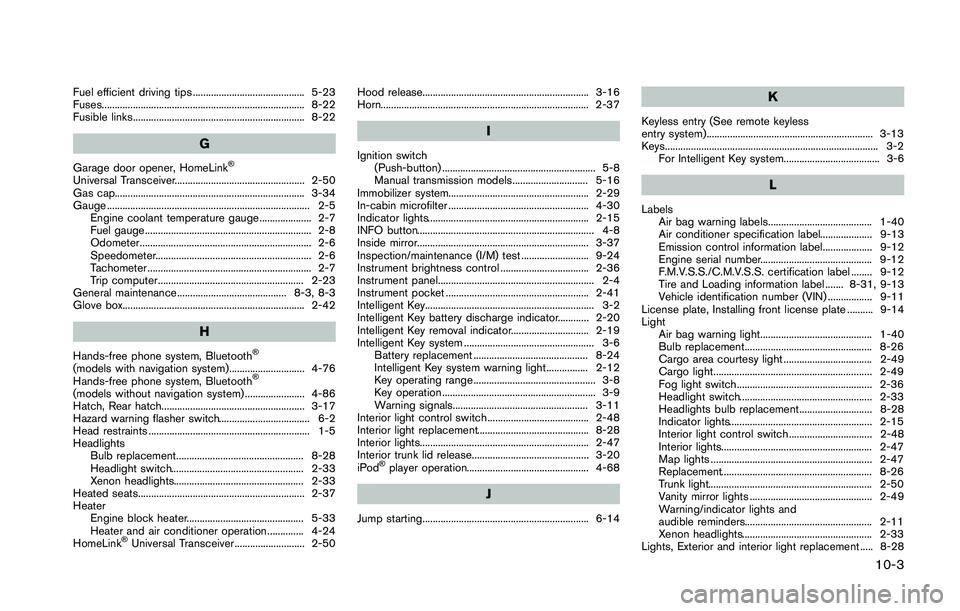2014 NISSAN 370Z lights
[x] Cancel search: lightsPage 70 of 428

SSI0509
1. ENTER/NEXT switch (P.2-23)
2. Fuel gauge (P.2-8)
3. Warning/Indicator lights (P.2-10)
4. Tachometer (P.2-7)
5. Speedometer (P.2-6)
6. Instrument brightness control switch (P.2-36)
7. Vehicle information display (P.2-18)8. Engine coolant temperature gauge (P.2-7)
9. Transmission position indicator (if so equipped)
(P.2-17)
— SynchroRev Match mode (S-MODE) indica-
tor (if so equipped) (P.5-17)
Page 98 of 428

XENON HEADLIGHTS
Page 113 of 428

SIC4239
INTERIOR LIGHT CONTROL SWITCH
The interior light control switch has three
positions: ON, DOOR and OFF.
ON position
When the switch is in the ON position*1the
map lights will illuminate.
DOOR position
When the switch is in the DOOR position*2,
the map lights will illuminate under the following
conditions:
. ignition switch is switched to the OFF or
LOCK position — remain on for about 15 seconds.
. doors are unlocked by pushing the UN-
LOCK button on the Intelligent Key or door
handle request switch with the ignition
switch in the LOCK position
— remain on for about 15 seconds.
. any door is opened and then closed with the
ignition switch in the LOCK position
— remain on for about 15 seconds.
. any door is opened with the ignition switch
in the ACC or ON position
— remain on while the door is opened.
When the door is closed, the lights go
off.
The lights will also turn off after a period of
time when the lights remain illuminated
after the ignition switch has been pushed
to the OFF or LOCK position to prevent the
battery from becoming discharged.
Models with navigation system:
When the auto interior illumination is set to the
OFF position (see “Vehicle information and
settings (models with navigation system)” (P.4-
7)), the lights will illuminate under the following
condition:
. any door is opened with the ignition switch
in any position — remain on while the door is opened.
When the door is closed, the lights go
off.
OFF position
When the switch is in the OFF position*3, the
lights will not illuminate, regardless of the
condition.
Page 298 of 428

.Make sure the area around the vehicle is
clear.
. Check fluid levels such as engine oil, cool-
ant, brake fluid and window washer fluid as
frequently as possible, or at least whenever
you refuel.
. Check that all windows and lights are clean.
. Visually inspect tires for their appearance
and condition. Also check tires for proper
inflation.
. Lock all doors.
. Position seat and adjust head restraints.
. Adjust inside and outside mirrors.
. Fasten seat belts and ask all passengers to
do likewise.
. Check the operation of warning lights when
the ignition switch is pushed to the ON
position. (See “Warning/indicator lights and
audible reminders” (P.2-10) .) 1. Apply the parking brake.
2.
Automatic Transmission (AT) model:
Move the shift lever to the P (Park) or N
(Neutral) position. (P is recommended.)
The starter is designed not to operate unless
the shift lever is in either of the above
positions.
Manual Transmission (MT) model:
Move the shift lever to the N (Neutral)
position. Depress the clutch pedal fully to
the floor.
The starter is designed not to operate unless
the clutch pedal is fully depressed.
The Intelligent Key must be carried
when operating the ignition switch.
3. Push the ignition switch to the ON position. Depress the brake pedal (AT model) or the
clutch pedal (MT model) and push the
ignition switch to start the engine.
To start the engine immediately, push and
release the ignition switch while depressing
the brake pedal with the ignition switch in
any position.
.If the engine is very hard to start inextremely cold weather or when restart-
ing, depress the accelerator pedal a little
(approximately 1/3 to the floor) and while
holding, crank the engine. Release the accelerator pedal when the engine starts.
.If the engine is very hard to start because
it is flooded, depress the accelerator
pedal all the way to the floor and hold it.
Push the ignition switch to the ON
position to start cranking the engine.
After 5 or 6 seconds, stop cranking by
pushing the ignition switch to OFF. After
cranking the engine, release the accel-
erator pedal. Crank the engine with your
foot off the accelerator pedal by
depressing the brake pedal and pushing
the push-button ignition switch to start
the engine. If the engine starts, but fails
to run, repeat the above procedure.
Page 310 of 428

CAUTION
During the first 1,200 miles (2,000 km) ,
follow these recommendations to ob-
tain maximum engine performance and
ensure the future reliability and econo-
my of your new vehicle.
Failure to follow these recommenda-
tions may result in shortened engine
life and reduced engine performance.
. Avoid driving for long periods at constant
speed, either fast or slow. Do not run the
engine over 4,000 rpm.
. Do not accelerate at full throttle in any gear.
. Avoid quick starts.
. Avoid hard braking as much as possible. Follow these easy-to-use Fuel Efficient Driving
Tips to help you achieve the most fuel economy
from your vehicle.
1. Use smooth accelerator and brake pedal
application.
.Avoid rapid starts and stops..Use smooth, gentle accelerator andbrake application whenever possible.
.Maintain constant speed while commut-
ing and coast whenever possible.
2. Maintain constant speed.
.Look ahead to try and anticipate and minimize stops.
.Synchronizing your speed with traffic
lights allows you to reduce your number
of stops.
.Maintaining a steady speed can minimize red light stops and improve fuel effi-
ciency.
3. Use air conditioning (A/C) at higher vehicle speeds.
.Below 40 MPH (64 km/h), it is moreefficient to open windows to cool the
vehicle due to reduced engine load.
.Above 40 MPH (64 km/h) , it is moreefficient to use A/C to cool the vehicle
due to increased aerodynamic drag.
.Recirculating the cool air in the cabinwhen the A/C is on reduces cooling load.
4. Drive at economical speeds and distances.
.Observing the speed limit and not ex- ceeding 60 MPH (97 km/h) (where
legally allowed) can improve fuel effi-
ciency due to reduced aerodynamic
drag.
.Maintaining a safe following distancebehind other vehicles reduces unneces-
sary braking.
.Safely monitoring traffic to anticipatechanges in speed permits reduced brak-
ing and smooth acceleration changes.
.Select a gear range suitable to road conditions.
5. Use cruise control.
.Using cruise control during highway driving helps maintain a steady speed.
.Cruise control is particularly effective in providing fuel savings when driving on
flat terrains.
6. Plan for the shortest route.
.Utilize a map or navigation system to determine the best route to save time.
7. Avoid idling.
.Shutting off your engine when safe for stops exceeding 30-60 seconds saves
Starting and driving5-23
BREAK-IN SCHEDULE FUEL EFFICIENT DRIVING TIPS
Page 323 of 428

SIC2574
Push the switch on to warn other drivers when
you must stop or park under emergency condi-
tions. All turn signal lights will flash.
Page 324 of 428

TIRE PRESSURE MONITORING SYS-
TEM (TPMS)
This vehicle is equipped with the Tire Pressure
Monitoring System (TPMS) . It monitors tire
pressure of all tires except the spare. When
the low tire pressure warning light is lit and the
CHECK TIRE PRESSURE warning appears on
the vehicle information display, one or more of
your tires is significantly under-inflated. If the
vehicle is being driven with low tire pressure, the
TPMS will activate and warn you of it by the low
tire pressure warning light. This system will
activate only when the vehicle is driven at
speeds above 16 MPH (25 km/h). For more
details, see “Warning/indicator lights and audi-
ble reminders” (P.2-10) and “Tire Pressure
Monitoring System (TPMS)” (P.5-3) .
Page 422 of 428

Fuel efficient driving tips ........................................... 5-23
Fuses.............................................................................. 8-22
Fusible links.................................................................. 8-22
G
Garage door opener, HomeLink®
Universal Transceiver.................................................. 2-50
Gas cap......................................................................... 3-34
Gauge .............................................................................. 2-5Engine coolant temperature gauge .................... 2-7
Fuel gauge................................................................ 2-8
Odometer.................................................................. 2-6
Speedometer............................................................ 2-6
Tachometer ............................................................... 2-7
Trip computer........................................................ 2-23
General maintenance .......................................... 8-3, 8-3
Glove box...................................................................... 2-42
H
Hands-free phone system, Bluetooth®
(models with navigation system)............................. 4-76
Hands-free phone system, Bluetooth®
(models without navigation system) ....................... 4-86
Hatch, Rear hatch....................................................... 3-17
Hazard warning flasher switch................................... 6-2
Head restraints .............................................................. 1-5
Headlights Bulb replacement................................................. 8-28
Headlight switch................................................... 2-33
Xenon headlights.................................................. 2-33
Heated seats................................................................ 2-37
Heater Engine block heater............................................. 5-33
Heater and air conditioner operation.............. 4-24
HomeLink
®Universal Transceiver ........................... 2-50 Hood release................................................................ 3-16
Horn................................................................................ 2-37
I
Ignition switch
(Push-button) ........................................................... 5-8
Manual transmission models............................. 5-16
Immobilizer system...................................................... 2-29
In-cabin microfilter ...................................................... 4-30
Indicator lights.............................................................. 2-15
INFO button.................................................................... 4-8
Inside mirror.................................................................. 3-37
Inspection/maintenance (I/M) test .......................... 9-24
Instrument brightness control .................................. 2-36
Instrument panel............................................................ 2-4
Instrument pocket ....................................................... 2-41
Intelligent Key................................................................. 3-2
Intelligent Key battery discharge indicator............ 2-20
Intelligent Key removal indicator.............................. 2-19
Intelligent Key system .................................................. 3-6 Battery replacement ............................................ 8-24
Intelligent Key system warning light................ 2-12
Key operating range ............................................... 3-8
Key operation ........................................................... 3-9
Warning signals.................................................... 3-11
Interior light control switch ....................................... 2-48
Interior light replacement........................................... 8-28
Interior lights................................................................. 2-47
Interior trunk lid release............................................. 3-20
iPod
®player operation............................................... 4-68
J
Jump starting................................................................ 6-14
K
Keyless entry (See remote keyless
entry system)................................................................ 3-13
Keys.................................................................................. 3-2 For Intelligent Key system..................................... 3-6
L
LabelsAir bag warning labels........................................ 1-40
Air conditioner specification label.................... 9-13
Emission control information label................... 9-12
Engine serial number........................................... 9-12
F.M.V.S.S./C.M.V.S.S. certification label ........ 9-12
Tire and Loading information label ....... 8-31, 9-13
Vehicle identification number (VIN) ................. 9-11
License plate, Installing front license plate .......... 9-14
Light Air bag warning light........................................... 1-40
Bulb replacement................................................. 8-26
Cargo area courtesy light .................................. 2-49
Cargo light............................................................. 2-49
Fog light switch.................................................... 2-36
Headlight switch................................................... 2-33
Headlights bulb replacement............................ 8-28
Indicator lights....................................................... 2-15
Interior light control switch ................................ 2-48
Interior lights.......................................................... 2-47
Map lights .............................................................. 2-47
Replacement.......................................................... 8-26
Trunk light............................................................... 2-50
Vanity mirror lights ............................................... 2-49
Warning/indicator lights and
audible reminders................................................. 2-11
Xenon headlights.................................................. 2-33
Lights, Exterior and interior light replacement ..... 8-28
10-3